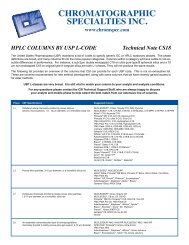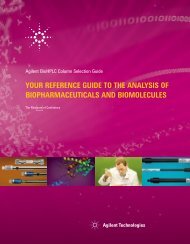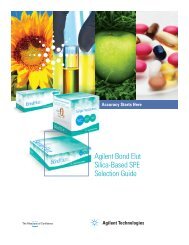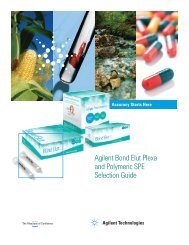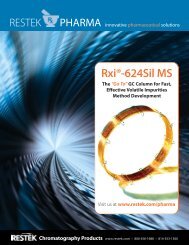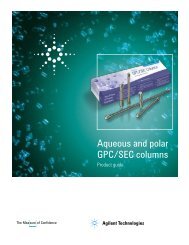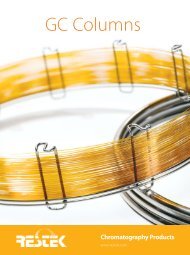Optimizing the Analysis of Volatile Organic Compounds
Optimizing the Analysis of Volatile Organic Compounds
Optimizing the Analysis of Volatile Organic Compounds
Create successful ePaper yourself
Turn your PDF publications into a flip-book with our unique Google optimized e-Paper software.
EPA Method Definitions<br />
Many EPA methods have been developed for <strong>the</strong> analysis <strong>of</strong> VOCs. Virtually all VOC methods<br />
employ purge and trap techniques to concentrate <strong>the</strong> volatiles from <strong>the</strong> sample matrix. The<br />
type <strong>of</strong> sample matrix being analyzed determines which method is used. We will discuss<br />
drinking water methods (500 series), wastewater methods (600 series), hazardous waste<br />
methods (8000 series), and Contract Laboratory Program (CLP) methods. In addition, we will<br />
discuss state gasoline range organic (GRO) methods.<br />
Drinking Water Methods (500 Series)<br />
Proposed in 1973 by <strong>the</strong> EPA and passed by Congress a year later, <strong>the</strong> Safe Drinking Water<br />
Act (SDWA) establishes national standards for drinking water from surface and ground water<br />
sources. These methods regulate <strong>the</strong> analysis <strong>of</strong> trace-level organic pollutants in drinking<br />
water. Enforcement <strong>of</strong> <strong>the</strong> SDWA provides that states shall have <strong>the</strong> primary authority, while<br />
<strong>the</strong> EPA will oversee activities pertaining to <strong>the</strong> public water supply system. These methods<br />
have evolved over <strong>the</strong> years, which has resulted in a growing list <strong>of</strong> compounds <strong>of</strong> interest in<br />
<strong>the</strong> subsequent revisions.<br />
Method 502.2: This capillary column GC method is used to monitor 60 regulated volatile<br />
contaminants in drinking water. It employs a purge and trap concentrator, combined with a<br />
photoionization detector (PID) and an electrolytic conductivity detector (ELCD) in series.<br />
The PID detects aromatic and double-bond compounds, and <strong>the</strong> ELCD detects halogenated<br />
compounds.<br />
Method 504: This capillary column GC method is used to monitor ethylene dibromide<br />
(EDB) and dibromochloropropane (DBCP) in drinking water. It employs microextraction,<br />
using hexane, and analysis using an electron capture detector (ECD).<br />
Method 524.2: This capillary column GC/mass spectroscopy (GC/MS) method is used to<br />
monitor <strong>the</strong> same 60 drinking water contaminants listed in Method 502.2. It also employs<br />
purge and trap concentration, but uses <strong>the</strong> MS to determine both aromatic and halogenated<br />
compounds.<br />
Method 524.2, Revision IV: This capillary column GC/MS method is used to monitor <strong>the</strong><br />
60 compounds listed in Methods 524.2 and 502.2, plus 24 additional compounds. As <strong>of</strong><br />
Fall 2001, revisions were proposed to replace hydrochloric acid sample preservation with<br />
sodium thiosulfate. These revisions, however, were not promulgated at <strong>the</strong> time <strong>of</strong> this<br />
printing.<br />
Wastewater Methods (600 Series)<br />
In 1977, President Carter signed <strong>the</strong> Clean Water Act (CWA) allowing <strong>the</strong> EPA to study and,<br />
if necessary, regulate 65 priority wastewater pollutants. A cooperative effort between environmental<br />
laboratories and <strong>the</strong> EPA resulted in <strong>the</strong> final version <strong>of</strong> what are now known as<br />
<strong>the</strong> 600 series methods. These methods regulate <strong>the</strong> analysis <strong>of</strong> organic pollutants in industrial<br />
and municipal wastewater discharges. They were written for packed GC columns, but<br />
most environmental laboratories now use capillary column technology.<br />
Method 601: This GC method was developed to monitor 29 halogenated volatile pollutants<br />
in wastewater. It employs purge and trap concentration combined with an ELCD.<br />
Method 602: This GC method was developed to monitor seven aromatic volatile pollutants<br />
in wastewater. It employs purge and trap concentration combined with a PID. Many laboratories<br />
combine Methods 601 and 602 by using a PID and an ELCD connected in series.<br />
Method 624: This GC/MS method uses purge and trap concentration to monitor 35 halogenated<br />
and aromatic volatile pollutants in wastewater.<br />
Method 1624: This isotope dilution GC/MS method uses purge and trap concentration to<br />
monitor 58 volatile pollutants in wastewater. Stable, isotopically labeled analogs <strong>of</strong> <strong>the</strong> target<br />
compounds are added to correct for analyte recoveries that might vary due to matrix interference<br />
in <strong>the</strong> analyzed samples.<br />
3<br />
www.restekcorp.com





